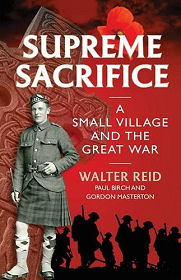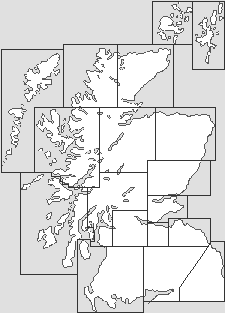 |
In 1911, Scotland's population was a little over 11% of the UK total: yet, by some estimates, during the First World War, Scots accounted for around a fifth of the UK's war dead. Over a century later, the most telling reminder of the sacrifice made by so many Scots can be found in the shape of the war memorials you find in just about every town and village throughout the length and breadth of the country. Many of these memorials later had added to them the names of those killed in the Second World War, but, almost without exception, the length of the lists of names of those killed in the century's first major conflict is much longer.
"Supreme Sacrifice: A Small Village and the Great War" by Walter Reid, Gordon Masterton and Paul Birch is a simply outstanding book that brings to life in the most immediate way imaginable the reality behind what can seem distant and oddly anonymous lists of names, even to those who take an interest in local history and war memorials. It does this by looking at one particular village, and telling the individual stories of the 72 men from the village who died in (or very shortly after) the First World War. Bridge of Weir is a Renfrewshire village some six miles west of Paisley. Its population in 1914 comprised some 1,000 men, 1,250 women, and 500 children. Accounts differ, but it seems that around 452 men from the village took up arms, and of them, nearly one man in six was killed in the conflict.
The war memorial unveiled in Bridge of Weir on 26 June 1921 listed the names of most of those who had been killed, and carried the text: "Let those who come after us see to it that their name be not forgotten." This book started with the realisation among some living in Bridge of Weir that while the actual names of those who died may not have been forgotten, pretty much everything else about them had. Its stated aim is to "create a faithful remembrance of those who died, in a spirit of respect for their sacrifice." It succeeds admirably, and it does a great deal more as well.
"Supreme Sacrifice" is a superbly researched book, and a very effectively organised and beautifully written one. You can view the core of the book as comprising the stories of each of the 72 men who died. More information was inevitably available about some than about others, but for most we find out a little about their family background and pre-war activities, their wartime service, and the circumstances of their death, with each being given between around half a page and two pages. There's a sense in which the stated aim of the book would have been met if it has simply set out those 72 personal stories. What really marks it out as exceptional, however, is the way the stories of the men who died are woven into the broader history of the war that killed them. As a result chapters recounting individual battles in which men from the village died are interspersed with chapters setting out the political and top-level military background to the carnage on the ground (and at sea, and in the air). We also have chapters setting out the history of Bridge of Weir itself; one telling the story of a conscientious objector from the village; and one recounting the consequences for the village of the conflict, of the loss of so many of its young men, and of the change in outlook and aspirations of others who had gone to war, or stayed behind.
The result is a book that serves as a worthy reminder of the sacrifice of the 72 men who died; and an excellent history of the war itself. It should be considered essential reading by anyone who's ever gazed at a list of names on a Scottish war memorial and wondered about the men behind the names. While this book focuses on just 72 of the huge number who died in the conflict, from just one village, their stories are typical of the stories of many others who did not return from the war, to towns and villages in every part of Scotland, and far beyond it.
InformationPaperback: 224 pagesBirlinn Ltd birlinn.co.uk 18 August 2016 Language: English ISBN-10: 1780273509 ISBN-13: 978-1780273501 Size: 12.9 x 1.8 x 19.8 cm Buy from Amazon (paid link) Visit Bookshop Main Page |
